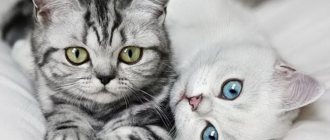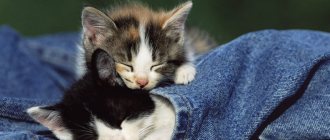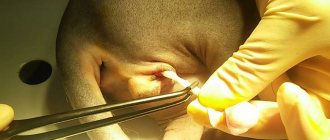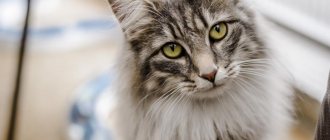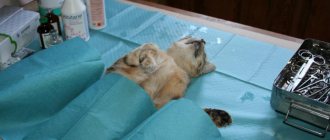12119Administration
1
People often get cats, but not everyone can imagine what problems they will have to face. And teaching them to go to the litter box is not the most important task for the owner. Even a cat at a very young age can cause a lot of problems when she begins puberty.
At what age do cats start walking? Every owner should know the answer to this question. And you must be prepared for this period in order to know how to proceed. After all, the task of every owner is to make the life of their pet happy and comfortable. He must do everything to ensure that the pet grows up healthy.
What is estrus
The period during which the behavior of an animal changes dramatically is called estrus, or estrus. At this moment, the process of ovulation begins in the eggs, and conception becomes real.
The following signs signal the beginning of the cat's walking period:
- There are sudden changes in mood. The cat can be overly affectionate, and a few minutes later aggressive;
- The pet meows loudly, calling for a male;
- Transparent discharge appears, the cat licks itself more often;
- Goes to the toilet more;
- Appetite decreases, some cats may refuse food altogether;
- Due to the reproductive instinct, many cats strive to get out of the room, so during the period of heat it is important to close all doors and windows;
- Gait changes appear. The cat bends its front paws and lifts its tail high.
The listed signs during estrus can be observed individually or in combination.
Cycle phases
The cycle of sexual activity can be divided into four phases:
- precursor or proestrus , which lasts on average 1-2 days;
- estrus - estrus, lasting 4-6 days;
- post-estrus or meteestrus – lasting 7-14 days;
- rest period/anestrus – about 90 days.
Each of these periods has its own manifestations and an individual duration for each cat. The first heat can go unnoticed by others, since due to the immaturity of the reproductive system, its signs are less pronounced.
Proestrus
Precursor is the courtship period when the body is just preparing for mating. Its characteristics and duration are determined by the hypothalamic-pituitary system. The glands regulate the synthesis of follicle-stimulating hormone, and estrogens act on the reproductive organs, preparing them for mating and fertilization.
Externally, proestrus manifests itself as follows:
- slight enlargement of the labia;
- clear, scanty mucous discharge;
- anxiety;
- decreased appetite;
- marking the territory;
- release of pheromones in urine;
- loud calls of invitation.
In the presence of a male, hormones are released more intensely, and the onset of the cycle occurs earlier. Any abnormalities in the structure and characteristics of the discharge may indicate a disease of the reproductive system. If mucus appears with traces of blood, an uneven structure or an unpleasant odor, you should immediately show the animal to a specialist.
Estrus
Actually, being in heat does not mean that ovulation will occur. Unlike dogs, in cats, a mature egg is released from the follicle in response to irritation of the vaginal walls by the rough head of the male genital organ.
To trigger the reflex mechanism of ovulation, several acts of mating are necessary. As a result of coitus, luteinizing hormone is released. It induces the ovulation process and regulates estrogen activity.
After ovulation, a corpus luteum is formed in the ovary, the glandular tissues of which produce progesterone. It is involved in maintaining pregnancy, preparing the uterine mucosa for implantation of a fertilized egg. The process of attachment of the embryo to the wall of the uterus occurs 2 weeks after coating.
Signs that a cat is ready to mate are:
- unusual behavior - the animal wriggles, rolls on the floor, takes a position convenient for copulation;
- increased sexuality and excitability;
- heart-rending screams.
External signs are absent or mild, there is no discharge. This stage lasts 4-6 days, and ovulation takes 1-1.5 days.
The onset of estrus can be accelerated artificially - put a rag soaked in the male’s urine, increase daylight hours to 14 hours with the help of lighting, and place the animal with an estrous female. If the female is uncovered, then after 1-2 weeks the cycle begins again.
During 1-3 heats, it is not recommended to breed a cat, since its reproductive system has not yet completed its formation, and pregnancy may not occur or may lead to diseases, death of offspring and other abnormalities.
Meteestrus
If ovulation occurs as a result of mating, the cat avoids sexual contact and may behave aggressively with the male. After fertilization, kittens are born after 9 weeks. When ovulation occurs and there is no fertilization, a false pregnancy is noted. The cat shows all the signs of pregnancy. She has:
- mammary glands swell;
- appetite increases;
- mood and character changes;
- concern for future offspring is shown - the cat builds a nest;
- there is anxiety, obsession;
- motor activity decreases.
False pregnancy lasts no more than 1-2 months. After the signs disappear, the cat is ready for a new cycle.
Anestrus
Sexual rest. This period lasts from November to January. All reproductive organs are in relative rest - the body is preparing for the next reproductive cycle. Longer than normal periods of rest may indicate diseases of the thyroid gland or congenital ovarian pathology.
Some animals have no periods of rest, and the animal constantly demonstrates readiness for sexual contact. This phenomenon is mistakenly called nymphomania. Constant waves of follicular maturation and estrus are characteristic of some breeds, such as Siamese, and are not an anomaly.
In other breeds, too long an estrus may be caused by a tumor or ovarian cyst. If there is any deviation from the natural duration of the cycle, you should consult a veterinarian so as not to miss the initial signs of the development of diseases of the endocrine and reproductive systems.
When cats start walking
The main question that worries cat breeders is at what age does a pet go into heat for the first time?
Several factors influence when a cat matures:
- Breed;
- Finding a male nearby;
- Dimensions of the animal;
- Cat color;
- Season.
On average, a cat begins to go into heat for the first time at 6-8 months . However, the process is quite individual and may not start for longer. The start of estrus before one year is considered the norm.
If your pet does not go into heat before the age of 1 year, this is a deviation and you should immediately seek the help of a veterinarian.
The phenomenon known as “erased estrus” is common. In this case, the process of sexual interest is almost not manifested. Most often occurs in unhealthy cats.
Ways to calm your cat
The modern world is progressing, and people have come up with many ways to ease the period of estrus, both for themselves and for their pet. The most popular and accessible ones will be discussed in more detail in this section.
Drugs
How many days before vaccination should a cat be given anthelmintic?
When resorting to tablets, the owner must be aware of the risk he is putting his pet’s health at. Hormonal drugs are difficult to tolerate even by people, not to mention animals. But if you still decide to buy tablets, you should consult a veterinarian. He will help you choose the right drug, determine the quantity and dosage.
Sterilization
Today, sterilization is the safest and most humane way to make life easier for both yourself and your cat. This method is suitable for owners who do not plan to breed a cat for breeding purposes. Medicine has reached such heights that sterilization is no longer a dangerous operation. Another advantage is the increase in the life expectancy of the pet.
Important! It is best to carry out the operation before the first heat.
Cat after sterilization
By the time a cat's first heat begins, the owner must prepare. To avoid any unpleasant surprises, you need to familiarize yourself with all the information about estrus in cats. Animals live by obeying their instincts, and owners should not forget that they are responsible for those they have tamed.
Stages of estrus in cats
There are 4 stages of estrus in cats, each of which is characterized by specific behavior. It should be remembered that it is advisable to match a cat with a male at the second stage, that is, 5-7 days from the start of estrus.
- Proestrus . The initial stage, characterized by restless behavior of the animal (it begins to rub against furniture, bend its front paws). Duration is up to 3 days.
- Estrus . Actually the estrus itself, which can last up to 10 days. During this period, all signs of estrus appear, sexual hunting occurs and the search for a male for fertilization occurs.
- Interestrus . At this stage, there is a decrease in sexual activity, especially if mating has occurred. The cat has a neutral attitude towards cats, perhaps even with aggression. In some cases, a false pregnancy may occur due to the physiological characteristics of the female.
- Anestrus . The final stage, when the instincts fade and the cat returns to its previous life.
Estrus frequency
How often does a cat go into heat? This is the question asked by every lover of four-legged friends who monitors its development and health. As a rule, the frequency of estrus depends on the characteristics of the breed. If you take the British Shorthair and the Siamese purr. The first is distinguished by infrequent estrus, unlike the second breed.
- Basically, under normal living conditions, a cat comes into heat once every three months.
- Another thing is a pet giving birth. The first estrus begins at 4-6 months after the kittens are born.
- But, you need to take into account this fact if the kittens died or were taken away. The cat will be ready for mating before the time indicated above.
How many days does a cat walk?
One of the main questions that arises for cat owners is how long do they walk? There is no clear answer to this question, since many factors influence the duration of estrus .
The duration of the period depends on:
- Age;
- Time spent without a cat;
- Living conditions;
- Environment, weather, time of year;
- Nutritional features;
- The physical condition of the cat;
- The nature of the pet's body.
In pets, estrus most often lasts from 5 to 10 days. The first estrus may be short-lived . With age, the duration increases, as the pet’s hormonal background forms and changes. In different breeds, a duration of up to 20 days can be observed.
Estrus requires constant monitoring by the breeder. You need to know how long your pet normally goes into heat.
If deviations occur and the heat lasts too long, this may indicate the presence of an ovarian cyst or tumor. A visit to the veterinarian is required to undergo an ultrasound examination.
Sterilization
A pet during the “hunt” can cause a lot of inconvenience to its household members - the animal does not let you sleep and screams at night. And in the future, if it is not planned to breed her regularly, empty heats can greatly harm the cat’s health: such animals often develop various inflammatory processes in the reproductive organs, neoplasms and cancerous tumors.
You should not use chemicals that regulate sexual desire - they will do much more harm than good. Various herbal remedies can come to the aid of owners, however, the effect of their use is quite short-lived - furry beauties quickly get used to them and stop reacting.
With the help of modern methods, the operation is carried out quickly and almost unnoticeably for the animal itself.
In rare cases, it happens that a cat walks after sterilization. This happens in a situation where the animal has not completely removed all the ovarian tissue or left the uterus, and the necessary hormones continue to be released. To determine the cause, you need to take hormone tests - the animal may need another operation.
How many times a year does a cat walk?
The frequency of estrus depends on whether the cat has given birth or not. As a rule, cats after giving birth go for walks once every two months, and sometimes once a year. It is impossible to give a definite answer to the question of how long after giving birth the estrus will begin. As a rule, this happens after a month, but it all depends on the specific breed and the nature of the birth.
If the cat has not given birth, estrus occurs quite often - once every two weeks or month. If the owner wants to reduce the frequency of festivities, you can allow the animal to reproduce, or contact a veterinarian to prescribe hormonal medications.
Duration of estrus in different cat breeds
The duration of estrus directly depends on the breed of the pet.
British women are known for the rarest periods of festivities. The first heat occurs at the age of 7 months. Over time, the regularity of ovulation and its duration are disrupted;
Scottish women are famous for their early puberty - at 5 months. The duration of estrus is up to 6 days, the frequency is several times a year.
How to relieve a cat's suffering?
Currently, there are many drugs on the veterinary market that stop and stop the estrus phase.
These are the means:
- Kowinan;
- contra-Sex;
- sex barrier;
- top-Intimate;
- the ex.
There are often situations when consultants in veterinary pharmacies advise owners who are tormented by the screams of their pets, hormonal drugs that occupy a certain place on the market. They can easily and quickly prevent or stop the phase of sexual arousal.
Their main disadvantage is the negative consequences of use. Hormones negatively affect the condition of internal organs, disrupt the functioning of the thyroid gland, and lead to an imbalance of organic minerals and enzymes.
Due to the use of hormonal drugs for estrus, the following diseases occur more often than others:
- pyometra - purulent inflammation of the uterus;
- malignant neoplasms in the uterus and ovaries;
- breast cancer.
Veterinarians do not recommend the use of such drugs. Sterilization is rightly considered an analogue of hormonal “treatment”. This is a surgical operation that involves removing the reproductive organs - the ovaries and uterus.
In the future, the cat stops “walking” without harm to health, life expectancy increases due to the absence of estrus stress factors in life. The animal becomes more sociable and affectionate, the need for male attention disappears completely.
Veterinarians and breeders around the world urge owners to sterilize females that are unsuitable for reproduction and breeding work. This will extend and improve the life of a particular female, control the number of stray animals, and create clean lines in breeding.
Females are traditionally sterilized before or after their first heat. The operation can be performed at an older age, but by then many contraindications arise. Before the operation, the animal must be examined by a veterinarian. He takes the necessary tests (biochemical and general blood tests), makes a cardiogram and, in rare cases, performs ultrasound diagnostics.
What to do if your cat doesn't walk
One of the deviations is the absence of estrus in a mature cat. Besides a visit to the veterinarian, there are several ways to help your pet:
- If there is a pet in the neighborhood who is in heat, he needs to be housed. As a rule, cats leak at the same time.
- If there is a cat nearby, it is also advisable to bring the animals closer together. If there is a male, the maturation of the egg will occur faster.
- If the cat is healthy, you can give vitamins and homeopathic remedies.
Average age
In veterinary medicine, there are two parallel concepts: sexual maturity (the moment the egg first matures) and actual maturity (the time when a cat is anatomically and physiologically capable of becoming pregnant, bearing and giving birth to viable kittens). The main difficulty is that these periods do not occur simultaneously and a cat can become pregnant before giving birth to healthy kittens.
The average age at which a pet shows the first need for contact with an individual of the opposite sex usually occurs in the first year of life: from 8 to 11 months. Often, in practice, these dates may shift somewhat, so the situation is considered normal when the animal goes on a spree for the first time at the age of six months.
Recommendations for owners when the cat is walking
The owners' actions during estrus should be aimed at ensuring the cat's comfort and maintaining her health.
Mating with a male
This event is the most beneficial for the cat. However, it should be remembered that earlier fertilization can result in complications and deterioration in health. It is recommended to breed a pet no earlier than a year.
Taking hormonal drugs
If the owner does not plan to breed a cat with a male, hormonal medications prescribed by a veterinarian can be used. Such remedies help regulate sexual desire for six months, weaken it, and avoid unwanted pregnancy in cats.
It should be remembered that the use of potent drugs is only possible for healthy pets, as side effects are possible. Hormonal medications also significantly increase cats' appetite.
This method involves removing the ovaries and uterus and has an irreversible effect. Older and unhealthy cats should not be spayed. A sterilized pet is no longer able to become pregnant, but some cats continue to walk after the procedure. This may be due to the fact that the operation was performed on a grown cat during estrus. To avoid such complications, it is recommended to sterilize your pet before puberty.
The period of estrus is a natural process indicating that a cat has reached puberty. As soon as the pet begins to walk, it is important to monitor it and in case of any deviations (long and frequent estrus, their absence for a long time) immediately contact a veterinarian.


